 Native to eastern and southern Asia, skunkvine is an invasive plant species introduced to the USDA Field Station near Brooksville before 1897. It has been included on the Florida Exotic Pest Plant Council List of Invasive Species as a Category I, defined as “species that are invading and disrupting native plant communities in Florida.” It was added to the Florida Noxious Weed List in 1999, making it illegal to possess, move, or release in Florida. This 3-page fact sheet was written by K. A. Langeland, R. K. Stocker, and D. M. Brazis, and published by the UF Department of Agronomy, February 2013.
Native to eastern and southern Asia, skunkvine is an invasive plant species introduced to the USDA Field Station near Brooksville before 1897. It has been included on the Florida Exotic Pest Plant Council List of Invasive Species as a Category I, defined as “species that are invading and disrupting native plant communities in Florida.” It was added to the Florida Noxious Weed List in 1999, making it illegal to possess, move, or release in Florida. This 3-page fact sheet was written by K. A. Langeland, R. K. Stocker, and D. M. Brazis, and published by the UF Department of Agronomy, February 2013.
http://edis.ifas.ufl.edu/wg208
Category: Ecosystems & Species
Freshwater Turtles of Belize (WEC328/UW373)
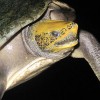 Belize, a country rich in natural resources and diverse wildlife, is home to nine species of freshwater turtles. Among these is the critically endangered hicatee, which has been eliminated in most of its range as a result of hunting and habitat loss. Freshwater turtles live in rivers, creeks, and lagoons, and build their nests on the banks. They eat a variety of plants, aquatic vegetation, and fruits. However, little is known about Belize’s unique turtle species. This 2-page fact sheet will help people identify, understand, and conserve these treasured resources. Written by Venetia Briggs, Lauren Watine, Dustin Smith, Robin Bijlani, Rebecca Harvey, William Giuliano, and Frank Mazzotti, and published by the UF Department of Wildlife Ecology and Conservation, January 2013.
Belize, a country rich in natural resources and diverse wildlife, is home to nine species of freshwater turtles. Among these is the critically endangered hicatee, which has been eliminated in most of its range as a result of hunting and habitat loss. Freshwater turtles live in rivers, creeks, and lagoons, and build their nests on the banks. They eat a variety of plants, aquatic vegetation, and fruits. However, little is known about Belize’s unique turtle species. This 2-page fact sheet will help people identify, understand, and conserve these treasured resources. Written by Venetia Briggs, Lauren Watine, Dustin Smith, Robin Bijlani, Rebecca Harvey, William Giuliano, and Frank Mazzotti, and published by the UF Department of Wildlife Ecology and Conservation, January 2013.
http://edis.ifas.ufl.edu/uw373
Tips for Integrating Land and Wildlife Management: Deer in Forests (WEC329/UW374)
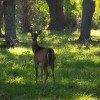 Prized by hunters and wildlife enthusiasts alike, white-tailed deer are a popular species found throughout Florida. As such, they are often the focus of management for landowners, managers, and lessees who want to improve deer populations while maintaining other land uses such as timber production. This 2-page fact sheet provides some deer habitat improvement tips that focus primarily on raising the quality of deer forage but that also will help you grow better cover by improving plant diversity and productivity. Written by William M. Giuliano, John M. Olson, and Cailey Thomas, and published by the UF Department of Wildlife Ecology and Conservation, January 2013.
Prized by hunters and wildlife enthusiasts alike, white-tailed deer are a popular species found throughout Florida. As such, they are often the focus of management for landowners, managers, and lessees who want to improve deer populations while maintaining other land uses such as timber production. This 2-page fact sheet provides some deer habitat improvement tips that focus primarily on raising the quality of deer forage but that also will help you grow better cover by improving plant diversity and productivity. Written by William M. Giuliano, John M. Olson, and Cailey Thomas, and published by the UF Department of Wildlife Ecology and Conservation, January 2013.
http://edis.ifas.ufl.edu/uw374
Tips for Integrating Land and Wildlife Management: Quail and Timber (WEC331/UW376)
 In Florida, changes in forest management practices during the past 50+ years have led to declines in quail habitat and populations. Important changes involve the use of fire and conversion of native forests to commercial pine plantations. A lack of fire and other disturbance has often led to closed-canopy forests with dense undergrowth that lack important quail habitat components. This 2-page fact sheet provides several quail habitat improvement tips that focus on diversifying the plant species and structural composition and increasing early successional communities dominated by herbaceous plants. Written by William M. Giuliano and Lauren Watine, and published by the UF Department of Wildlife Ecology and Conservation, January 2013.
In Florida, changes in forest management practices during the past 50+ years have led to declines in quail habitat and populations. Important changes involve the use of fire and conversion of native forests to commercial pine plantations. A lack of fire and other disturbance has often led to closed-canopy forests with dense undergrowth that lack important quail habitat components. This 2-page fact sheet provides several quail habitat improvement tips that focus on diversifying the plant species and structural composition and increasing early successional communities dominated by herbaceous plants. Written by William M. Giuliano and Lauren Watine, and published by the UF Department of Wildlife Ecology and Conservation, January 2013.
http://edis.ifas.ufl.edu/uw376
Native Pitcherplants of Florida (WEC333/UW378)
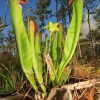 Pitcherplants are perennial plants with groups of leaves modified into traps or pitchers. They have tubular leaves with lids or hoods at the top that secrete nectar to attract prey. Once insects are on the lip of the pitcher, they can slip on the waxy opening and fall into the plant. This 5-page fact sheet provides descriptions of the ranges, appearance, and flowering of the six pitcherplant species native to Florida. Written by Megan E. Brown and Debbie L. Miller, and published by the UF Department of Wildlife Ecology and Conservation, January 2013.
Pitcherplants are perennial plants with groups of leaves modified into traps or pitchers. They have tubular leaves with lids or hoods at the top that secrete nectar to attract prey. Once insects are on the lip of the pitcher, they can slip on the waxy opening and fall into the plant. This 5-page fact sheet provides descriptions of the ranges, appearance, and flowering of the six pitcherplant species native to Florida. Written by Megan E. Brown and Debbie L. Miller, and published by the UF Department of Wildlife Ecology and Conservation, January 2013.
http://edis.ifas.ufl.edu/uw378
Enemigos naturales y control biologico (ENY866/IN977)
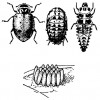 Hay muchos insectos benéficos pero solamente hay algunos que son enemigos naturales de plagas. Los enemigos naturales más comunes de encontrar son: mariquitas/tortolitas, crisopas, antocóridos (Orius), ligaéidos, sírfidos, avispas de agallas, hormigas, avispas parasíticas, moscas parasíticas y ácaros depredadores. La importancia relativa varía de acuerdo con cada insecto plaga, el hábitat y la estación o época del año. This 7-page fact sheet was written by Hugh A. Smith y John L. Capinera, traducido por Ana Lucrecia MacVean, and published by the UF Department of Entomology and Nematology, January 2013.
Hay muchos insectos benéficos pero solamente hay algunos que son enemigos naturales de plagas. Los enemigos naturales más comunes de encontrar son: mariquitas/tortolitas, crisopas, antocóridos (Orius), ligaéidos, sírfidos, avispas de agallas, hormigas, avispas parasíticas, moscas parasíticas y ácaros depredadores. La importancia relativa varía de acuerdo con cada insecto plaga, el hábitat y la estación o época del año. This 7-page fact sheet was written by Hugh A. Smith y John L. Capinera, traducido por Ana Lucrecia MacVean, and published by the UF Department of Entomology and Nematology, January 2013.
http://edis.ifas.ufl.edu/in977
Air Potato Leaf Beetle (Suggested Common Name), Lilioceris cheni Gressitt and Kimoto (Insecta: Coleoptera: Chrysomelidae: Criocerinae) (EENY547/IN972)
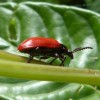 This leaf feeding beetle was recently introduced into Florida from China for biological control of air potato. This 4-page fact sheet provides information on the distribution, appearance, life cycle, host range and importance of the beetle. Written by Entomology and Nematology, and published by the UF Department of Ted D. Center and William A. Overholt, January 2013.
This leaf feeding beetle was recently introduced into Florida from China for biological control of air potato. This 4-page fact sheet provides information on the distribution, appearance, life cycle, host range and importance of the beetle. Written by Entomology and Nematology, and published by the UF Department of Ted D. Center and William A. Overholt, January 2013.
http://edis.ifas.ufl.edu/in972
Tips for Integrating Land and Wildlife Management: Quail in Cattle Country (WEC332/UW377)
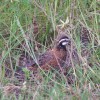 This 2-page fact sheet provides specific tips to improve quail habitat in cattle country that focus on diversifying the plant species and structural composition and increasing early successional communities dominated by herbaceous plants. Written by William M. Giuliano and Lauren Watine, and published by the UF Department of Wildlife Ecology and Conservation, January 2013.
This 2-page fact sheet provides specific tips to improve quail habitat in cattle country that focus on diversifying the plant species and structural composition and increasing early successional communities dominated by herbaceous plants. Written by William M. Giuliano and Lauren Watine, and published by the UF Department of Wildlife Ecology and Conservation, January 2013.
http://edis.ifas.ufl.edu/uw377
Puss Caterpillar (Larva), Southern Flannel Moth (Adult), Megalopyge opercularis (J. E. Smith 1797) (Insecta: Lepidoptera: Zygaenoidea: Megalopygidae) (EENY545/IN976)
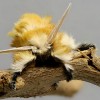 The southern flannel moth is an attractive small moth that is best-known because of its larva, the puss caterpillar, which is one of the most venomous caterpillars in the United States. This 12-page fact sheet was written by Donald W. Hall, and published by the UF Department of Entomology and Nematology, January 2013.
The southern flannel moth is an attractive small moth that is best-known because of its larva, the puss caterpillar, which is one of the most venomous caterpillars in the United States. This 12-page fact sheet was written by Donald W. Hall, and published by the UF Department of Entomology and Nematology, January 2013.
http://edis.ifas.ufl.edu/in976
Spiral Nematode, Helicotylenchus pseudorobustus (Steiner, 1941) Golden, 1956 (Nematoda: Tylenchida: Hoplolaimidae) (EENY544/IN973)
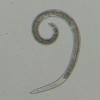 Spiral nematodes of the genus Helicotylenchus are among the most ubiquitous plant-parasitic nematodes worldwide. Helicotylenchus pseudorobustus is a species common in Florida and the southeastern United States and is frequently found associated with turfgrasses and other grass hosts in the region. On most plants, it is not considered particularly damaging, but recent research has shown that this species suppresses growth of certain turfgrass hosts. Seashore paspalum, a turfgrass used in tropical and subtropical regions, is particularly susceptible to infestation. This 4-page fact sheet was written by William T. Crow, and published by the UF Department of Entomology and Nematology, January 2013.
Spiral nematodes of the genus Helicotylenchus are among the most ubiquitous plant-parasitic nematodes worldwide. Helicotylenchus pseudorobustus is a species common in Florida and the southeastern United States and is frequently found associated with turfgrasses and other grass hosts in the region. On most plants, it is not considered particularly damaging, but recent research has shown that this species suppresses growth of certain turfgrass hosts. Seashore paspalum, a turfgrass used in tropical and subtropical regions, is particularly susceptible to infestation. This 4-page fact sheet was written by William T. Crow, and published by the UF Department of Entomology and Nematology, January 2013.
http://edis.ifas.ufl.edu/in973
A mosquito Psorophora ciliata (Fabricius) (Insecta: Diptera: Culicidae) (EENY540/IN967)
 Psorophora ciliata (Fabricius) is a large mosquito that has developed an outsized reputation because of its relatively intimidating heft and persistent biting behavior, including anecdotal historical accounts of its legendary aggressiveness and ‘frightening appearance’. This 6-page fact sheet was written by Ephraim V. Ragasa and Phillip E. Kaufman, and published by the UF Department of Entomology and Nematology, October 2012.
Psorophora ciliata (Fabricius) is a large mosquito that has developed an outsized reputation because of its relatively intimidating heft and persistent biting behavior, including anecdotal historical accounts of its legendary aggressiveness and ‘frightening appearance’. This 6-page fact sheet was written by Ephraim V. Ragasa and Phillip E. Kaufman, and published by the UF Department of Entomology and Nematology, October 2012.
http://edis.ifas.ufl.edu/in967
A Colonial tentweb orbweaver Cyrtophora citricola (EENY535/IN966)
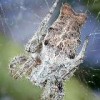 Few species of spiders can be considered truly social, but a greater number of species, particularly web-building spiders, live in close proximity to one another. One species which has become highly successful through a lifestyle of colonial aggregation is the orbweaver Cyrtophora citricola Forskål. This 6-page fact sheet was written by Lionel A. Stange, and published by the UF Department of Entomology and Nematology, October 2012.
Few species of spiders can be considered truly social, but a greater number of species, particularly web-building spiders, live in close proximity to one another. One species which has become highly successful through a lifestyle of colonial aggregation is the orbweaver Cyrtophora citricola Forskål. This 6-page fact sheet was written by Lionel A. Stange, and published by the UF Department of Entomology and Nematology, October 2012.
http://edis.ifas.ufl.edu/in966
Classical Biological Control of Tropical Soda Apple with Gratiana boliviana (ENY865/IN971)
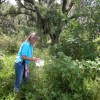 Tropical soda apple is a prickly shrub native to South America. First reported in Glades Co., Florida in 1988, it later spread to Georgia, Alabama, Louisiana, Texas, Mississippi, Tennessee, North Carolina, and South Carolina. It is a major problem in pastures and conservation areas. Negative impacts of tropical soda apple include reduction of cattle stocking rates, competition with native plants, and the costs associated with its control. Dense thickets of the weed also can disrupt the movement of wildlife. This 4-page fact sheet provides a summary of the major steps of the successful biological control program against tropical soda apple in Florida. The article covers the importance of the weed, identification and biology of the biological control agent, rearing and release efforts, establishment and impact, and efforts to communicate the outcomes of the program to stakeholders. Written by R. Diaz, J. Medal, K. Hibbard, A. Roda, A. Fox, S. Hight, P. Stansly, B. Sellers, J. Cuda and W. A. Overholt, and published by the UF Department of Entomology and Nematology, November 2012.
Tropical soda apple is a prickly shrub native to South America. First reported in Glades Co., Florida in 1988, it later spread to Georgia, Alabama, Louisiana, Texas, Mississippi, Tennessee, North Carolina, and South Carolina. It is a major problem in pastures and conservation areas. Negative impacts of tropical soda apple include reduction of cattle stocking rates, competition with native plants, and the costs associated with its control. Dense thickets of the weed also can disrupt the movement of wildlife. This 4-page fact sheet provides a summary of the major steps of the successful biological control program against tropical soda apple in Florida. The article covers the importance of the weed, identification and biology of the biological control agent, rearing and release efforts, establishment and impact, and efforts to communicate the outcomes of the program to stakeholders. Written by R. Diaz, J. Medal, K. Hibbard, A. Roda, A. Fox, S. Hight, P. Stansly, B. Sellers, J. Cuda and W. A. Overholt, and published by the UF Department of Entomology and Nematology, November 2012.
http://edis.ifas.ufl.edu/in971
Classical Biological Control of Air Potato in Florida (ENY864/IN957)
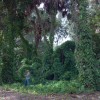 Air potato was introduced to Florida in 1905. By the 1980s, its vines were growing in thickets, waste areas, and hedges or fencerows in many parts of south and central Florida. By 1999, it was recognized as transforming plant communities by displacing native species, changing community structure and disrupting ecological functions. The air potato leaf beetle is a rather large, orange-red Asian leaf beetle. It feeds and develops only on air potato. The USDA-ARS Invasive Plant laboratory in Fort Lauderdale acquired this beetle from China and has begun an ambitious release program aimed at controlling air potato. This 3-page fact sheet was written by T. D. Center and W. A. Overholt, and published by the UF Department of Entomology and Nematology, October 2012.
Air potato was introduced to Florida in 1905. By the 1980s, its vines were growing in thickets, waste areas, and hedges or fencerows in many parts of south and central Florida. By 1999, it was recognized as transforming plant communities by displacing native species, changing community structure and disrupting ecological functions. The air potato leaf beetle is a rather large, orange-red Asian leaf beetle. It feeds and develops only on air potato. The USDA-ARS Invasive Plant laboratory in Fort Lauderdale acquired this beetle from China and has begun an ambitious release program aimed at controlling air potato. This 3-page fact sheet was written by T. D. Center and W. A. Overholt, and published by the UF Department of Entomology and Nematology, October 2012.
http://edis.ifas.ufl.edu/in957
Green lacewings (of Florida) Neuroptera: Chrysopidae (EENY534/IN965)
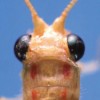 The Chrysopidae are one of the largest and economically most important families of the Neuroptera. There are about 1,300 currently recognized species included in about 87 genera and three subfamilies (Brooks and Bernard 1990) in the world. In Florida, there are 22 species in 9 genera, all placed in the subfamily Chrysopinae (Penny et al. 1997). The larvae are voracious predators of small, comparatively soft-bodied arthropods such as aphids, scale insects, whiteflies, thrips, insect eggs, and other prey (Muma 1959; Canard et al. 1984). For this reason they are used widely in biological control. The adults are usually predators, but a few species only feed on pollen. This 4-page fact sheet includes Key to the Genera of Green Lacewings of Florida. Written by Lionel A. Stange, and published by the UF Department of Entomology and Nematology, November 2012.
The Chrysopidae are one of the largest and economically most important families of the Neuroptera. There are about 1,300 currently recognized species included in about 87 genera and three subfamilies (Brooks and Bernard 1990) in the world. In Florida, there are 22 species in 9 genera, all placed in the subfamily Chrysopinae (Penny et al. 1997). The larvae are voracious predators of small, comparatively soft-bodied arthropods such as aphids, scale insects, whiteflies, thrips, insect eggs, and other prey (Muma 1959; Canard et al. 1984). For this reason they are used widely in biological control. The adults are usually predators, but a few species only feed on pollen. This 4-page fact sheet includes Key to the Genera of Green Lacewings of Florida. Written by Lionel A. Stange, and published by the UF Department of Entomology and Nematology, November 2012.
http://edis.ifas.ufl.edu/in965
How to Use Deterrents to Stop Damage Caused by Nuisance Wildlife in Your Yard (WEC326/UW371)
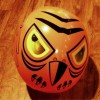 Many of us try to attract particular types of wildlife to our yards so that we can observe them. We often select plants and other materials that we know provide food, cover, and water for those animals we like to watch. However, when unwanted wildlife visit your yard and cause damage, you might need to consider the use of tactics that could deter these unwanted species. This 8-page fact sheet was written by Holly K. Ober and Arlo Kane, and published by the UF Department of Wildlife Ecology and Conservation, October 2012.
Many of us try to attract particular types of wildlife to our yards so that we can observe them. We often select plants and other materials that we know provide food, cover, and water for those animals we like to watch. However, when unwanted wildlife visit your yard and cause damage, you might need to consider the use of tactics that could deter these unwanted species. This 8-page fact sheet was written by Holly K. Ober and Arlo Kane, and published by the UF Department of Wildlife Ecology and Conservation, October 2012.
http://edis.ifas.ufl.edu/uw371
How To Identify the Wildlife Species Responsible for Damage in Your Yard (WEC324/UW369)
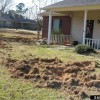 Although many homeowners enjoy wildlife in their yards, there are situations where wildlife can become a nuisance. In some circumstances, wild animals can cause extensive damage to lawns and gardens. Learning to identify which species is responsible for this damage is the first step in finding a solution to the problem. This 6-page fact sheet provides images of wildlife damage in residential settings to help you determine which species may be causing similar problems in your yard. Written by Holly K. Ober and Arlo Kane, and published by the UF Department of Wildlife Ecology and Conservation, October 2012.
Although many homeowners enjoy wildlife in their yards, there are situations where wildlife can become a nuisance. In some circumstances, wild animals can cause extensive damage to lawns and gardens. Learning to identify which species is responsible for this damage is the first step in finding a solution to the problem. This 6-page fact sheet provides images of wildlife damage in residential settings to help you determine which species may be causing similar problems in your yard. Written by Holly K. Ober and Arlo Kane, and published by the UF Department of Wildlife Ecology and Conservation, October 2012.
http://edis.ifas.ufl.edu/uw369
Overview of How to Stop Damage Caused by Nuisance Wildlife in Your Yard (WEC323/UW368)
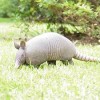 In Florida, we are fortunate to have a wide variety of wildlife to watch and enjoy. Indeed, many homeowners attempt to attract particular types of wildlife to their yards to watch. However, wild animals can become a nuisance in some situations. This 4-page fact sheet is the first in a five-part series describing tactics you can use to cope with wildlife that have become a nuisance. Here we suggest a sequence of steps you can implement when wildlife are causing damage in your yard. These suggestions should help reduce wildlife damage in a practical, humane, and environmentally responsible manner. Written by Holly K. Ober and Arlo Kane, and published by the UF Department of Wildlife Ecology and Conservation, October 2012.
In Florida, we are fortunate to have a wide variety of wildlife to watch and enjoy. Indeed, many homeowners attempt to attract particular types of wildlife to their yards to watch. However, wild animals can become a nuisance in some situations. This 4-page fact sheet is the first in a five-part series describing tactics you can use to cope with wildlife that have become a nuisance. Here we suggest a sequence of steps you can implement when wildlife are causing damage in your yard. These suggestions should help reduce wildlife damage in a practical, humane, and environmentally responsible manner. Written by Holly K. Ober and Arlo Kane, and published by the UF Department of Wildlife Ecology and Conservation, October 2012.
http://edis.ifas.ufl.edu/uw368
How to Modify Habitat to Discourage Nuisance Wildlife in Your Yard (WEC325/UW370)
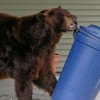 Although often overlooked, habitat modification is the cheapest and most effective long-term solution to nuisance wildlife problems in residential landscapes. Removing the resources wildlife are seeking when they visit your yard can be a much more cost-effective solution than restricting access to those resources with physical barriers, scaring wildlife with hazing tactics, deterring wildlife with repellents, or removing wildlife by trapping or killing nuisance animals. This 3-page fact sheet was written by Holly K. Ober and Arlo Kane, and published by the UF Department of Wildlife Ecology and Conservation, October 2012.
Although often overlooked, habitat modification is the cheapest and most effective long-term solution to nuisance wildlife problems in residential landscapes. Removing the resources wildlife are seeking when they visit your yard can be a much more cost-effective solution than restricting access to those resources with physical barriers, scaring wildlife with hazing tactics, deterring wildlife with repellents, or removing wildlife by trapping or killing nuisance animals. This 3-page fact sheet was written by Holly K. Ober and Arlo Kane, and published by the UF Department of Wildlife Ecology and Conservation, October 2012.
http://edis.ifas.ufl.edu/uw370
How to Use Traps to Catch Nuisance Wildlife in Your Yard (WEC327/UW372)
 When wildlife become a nuisance in your yard, there are three general approaches you can take: make habitat modifications, use deterrents, or trap animals. In most residential settings, making habitat modifications or using deterrents will be both simpler and more effective than trapping. But trapping is warranted in certain situations when trying to solve conflicts between people and wildlife. This 6-page fact sheet provides information on stopping wildlife damage through the use of trapping. Written by Holly K. Ober and Arlo Kane, and published by the UF Department of Wildlife Ecology and Conservation, October 2012.
When wildlife become a nuisance in your yard, there are three general approaches you can take: make habitat modifications, use deterrents, or trap animals. In most residential settings, making habitat modifications or using deterrents will be both simpler and more effective than trapping. But trapping is warranted in certain situations when trying to solve conflicts between people and wildlife. This 6-page fact sheet provides information on stopping wildlife damage through the use of trapping. Written by Holly K. Ober and Arlo Kane, and published by the UF Department of Wildlife Ecology and Conservation, October 2012.
http://edis.ifas.ufl.edu/uw372